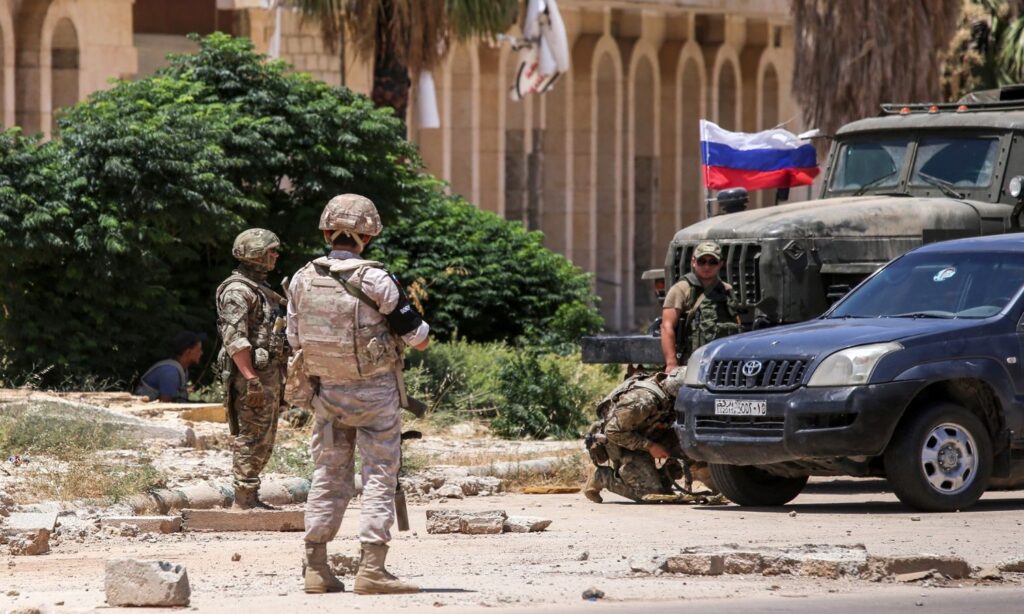The Syrian Network for Human Rights (SNHR) documented the killing of about seven thousand civilians, 44% of whom were children and women, by Russian forces since their military intervention in Syria on September 30, 2015.
This was stated in a report by the SNHR today, Monday, September 30, on the ninth anniversary of the Russian military intervention in Syria, which helped the Syrian regime regain control of vast areas of Syrian territory after losing control between 2011 and 2015.
362 Russian massacres
Russian forces have killed 6,969 civilians, including 2,055 children and 983 women (adult females), and committed at least 362 massacres between September 30, 2015, and the end of September this year.
Data analysis showed that the first year of the Russian intervention (2015-2016) witnessed the highest rate of casualties, with 3,564 civilians killed in that year, representing approximately 51% of the total casualties over the nine years.
Aleppo recorded the highest number of casualties (about 41%) among Syrian governorates, followed by Idlib (about 38%).
The report also documented that Russian forces killed 70 medical personnel, including 12 women, mostly in Idlib governorate (31 victims), and 24 media personnel, all of whom were killed in Aleppo and Idlib governorates.
Russia committed at least 1,251 attacks on vital civilian centers, including 224 schools, 209 medical facilities, and 61 markets. Idlib governorate recorded the highest number of attacks with 633 incidents, representing 51% of the total number of attacks.
The report also recorded at least 237 cluster bomb attacks, as well as at least 125 incendiary weapon attacks, carried out by Russian forces since their military intervention in Syria.
Support in various fields
The Syrian Network for Human Rights stated that Russian support for the Syrian regime was not limited to the military side, but extended to various fields, including justifying the Syrian regime’s use of chemical weapons, exploiting cross-border humanitarian aid, and utilizing media outlets for propaganda in favor of the Syrian regime.
Political support from Russia was evident in its opposition to any international condemnation of the Syrian regime in the Security Council, where Russia has paralyzed the council’s efforts to hold the Syrian regime accountable for crimes against humanity it committed, using its veto 18 times.
The director of the Syrian Network for Human Rights, Fadel Abdul Ghany, said that despite the thousands of violations committed by Russia in Syria, it has not opened a single investigation into its forces’ violations, nor held any commander accountable for bombing hospitals, markets, and schools, and it denies all documented reports, accusing them of falsification and misleading.
114 Russian sites
While Russia was escalating its air bombardment on civilians, it also sought to establish military bases and points, which reached 132 locations in 2022, but the number of Russian military sites in Syria decreased to 105 in 2023, with the outbreak of the Russian-Ukrainian war.
However, Moscow quickly increased its military sites in Syria again during the period between mid-2023 and 2024, rising from 105 to 114 sites, according to the Jusoor Center for Studies.
Russian sites in Syria consist of 21 bases and 93 military points, with 17 in Hama, 15 in Latakia, 14 in al-Hasakah, 13 in Quneitra, 12 in Aleppo, 8 in rural Damascus, 8 in Raqqa, 8 in Deir Ezzor, 6 in Idlib, 4 in Homs, 3 in Daraa, and 2 sites each in the governorates of Damascus, As-Suwayda, and Tartus.
Most of the increase in the number of Russian sites during the first half of 2024 resulted from the deployment of these forces within several new sites that were vacated by Iranian militias in the Quneitra governorate.
Dr. Nasr al-Yousef, an expert on Russian affairs, believes that Russia today dominates the strategic decision-making of the Syrian state, meaning that Bashar al-Assad cannot make any decision without Moscow’s approval, and if there is any procrastination, he is summoned to Moscow to receive instructions for immediate implementation without any hesitation or complaint.
In a previous interview with Enab Baladi, al-Yousef confirmed that the Hmeimim Airport and the Tartus naval base are strong arms for Russia in confronting its European enemies, and the Mediterranean Sea has become the boundary between Russian forces and Europe, meaning that Russia can strike Europe in its flank through its bases in Syria.
Failure to maintain security
Despite the signing of de-escalation and ceasefire agreements between Russia and Turkey in northern Syria, Moscow has failed to deter the Syrian regime from escalating against civilians.
Last August witnessed a military escalation, where the Syrian Network for Human Rights documented the killing of 57 civilians in Syria in August alone, 21 of whom were killed by regime forces, as the latter did not stop its attacks towards areas controlled by the Syrian National Army (SNA) or Hayat Tahrir al-Sham (HTS), including an attack on a Turkish observation point in de-escalation zones.
The Russian failure to maintain security after nine years of intervention in Syria is not limited to de-escalation zones in northern Syria, but also extends to reconciled areas under Russian supervision.
In southern Syria, Daraa governorate repeatedly witnesses escalations between local armed groups and regime forces in rural Daraa, where local groups target regime forces in response to kidnapping or arrest incidents involving the governorate’s residents at the hands of the regime’s intelligence, despite the “Russian mediation”.











